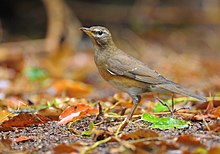Eyebrowed thrush
| Eyebrowed thrush Temporal range: Late Pleistocene – present | |
|---|---|

| |
| Scientific classification | |
| Domain: | Eukaryota |
| Kingdom: | Animalia |
| Phylum: | Chordata |
| Class: | Aves |
| Order: | Passeriformes |
| Family: | Turdidae |
| Genus: | Turdus |
| Species: | T. obscurus |
| Binomial name | |
| Turdus obscurus Gmelin, JF, 1789 | |
The eyebrowed thrush (Turdus obscurus) is a member of the thrush family Turdidae. It breeds in dense coniferous forest and taiga eastwards from Siberia and Mongolia to Japan. It is strongly migratory, wintering south to China and Southeast Asia. It is a rare vagrant to western Europe.
Taxonomy
The eyebrowed thrush was formally described in 1789 by the German naturalist Johann Friedrich Gmelin in his revised and expanded edition of Carl Linnaeus's Systema Naturae. He placed it with the thrushes in the genus Turdus and coined the binomial name Turdus obscurus.[2][3] The scientific name comes from Latin Turdus meaning "thrush" and obscurus meaning "dark" or "dusky".[4] Gmelin based his account on the "Dark thrush" that had been described in 1783 by the English ornithologist John Latham in his multi-volume work A General Synopsis of Birds. Latham noted that "This is Sibirian species and found in the woods beyond Lake Baikal" but did not explain the source of his information.[5] The species is monotypic: no subspecies are recognised.[6]
Description
This is an attractive thrush, with a grey back and head, the latter having a black eyeline, bordered white above and below. The breast and flanks are orange, and the belly white. The sexes are fairly similar, but immatures have a browner back.
The male has a simple whistling song, similar to the related mistle thrush.
Behaviour
It nests in trees, laying 4-6 eggs in a neat nest. Migrating birds and wintering birds often form small flocks. It is omnivorous, eating a wide range of insects, earthworms and berries.
In 2007 an eyebrowed thrush was sighted at the Jerusalem Bird Observatory in Jerusalem.[7] This is the second recorded sighting in Israel; the first was at Eilat in October 1996.
In 2011, an eyebrowed thrush was sighted in Australia, near Malanda in Queensland.[8] This is possibly the first confirmed sighting of the species on the Australian mainland.
Fossil record
In 2017, an assessment of late Pleistocene Indonesian passerines found a fossil of this species.[9]
Gallery
- Egg, Collection Museum Wiesbaden
References
- ^ BirdLife International (2016). "Turdus obscurus". IUCN Red List of Threatened Species. 2016: e.T22708793A94177211. doi:10.2305/IUCN.UK.2016-3.RLTS.T22708793A94177211.en. Retrieved 12 November 2021.
- ^ Gmelin, Johann Friedrich (1789). Systema naturae per regna tria naturae : secundum classes, ordines, genera, species, cum characteribus, differentiis, synonymis, locis (in Latin). Vol. 1, Part 2 (13th ed.). Lipsiae [Leipzig]: Georg. Emanuel. Beer. p. 816.
- ^ Mayr, Ernst; Paynter, Raymond A. Jr, eds. (1964). Check-List of Birds of the World. Vol. 10. Cambridge, Massachusetts: Museum of Comparative Zoology. p. 201.
- ^ Jobling, James A. (2010). The Helm Dictionary of Scientific Bird Names. London: Christopher Helm. pp. 278, 393. ISBN 978-1-4081-2501-4.
- ^ Latham, John (1783). A General Synopsis of Birds. Vol. 2, Part 1. London: Printed for Leigh and Sotheby. p. 31, No. 24.
- ^ Gill, Frank; Donsker, David; Rasmussen, Pamela, eds. (July 2023). "Thrushes". IOC World Bird List Version 13.2. International Ornithologists' Union. Retrieved 15 August 2023.
- ^ Jacobs, Megan (5 November 2007). "Rare bird is sighted in Jerusalem". Jerusalem Post. Retrieved 4 October 2017.
- ^ "Eye-browed Thrush – First for Australia, Feb. 9, 2011, Bird-o.com". Archived from the original on 2012-07-08. Retrieved 2011-12-08.
- ^ Meijer, Hanneke J.M.; Awe Due, Rokus; Sutikna, Thomas; Saptomo, Wahyu; Jatmiko; Wasisto, Sri; Tocheri, Matthew W.; Mayr, Gerald (2017-08-17). "Late Pleistocene songbirds of Liang Bua (Flores, Indonesia); the first fossil passerine fauna described from Wallacea". PeerJ. 5: e3676. doi:10.7717/peerj.3676. PMC 5563437. PMID 28828271.




